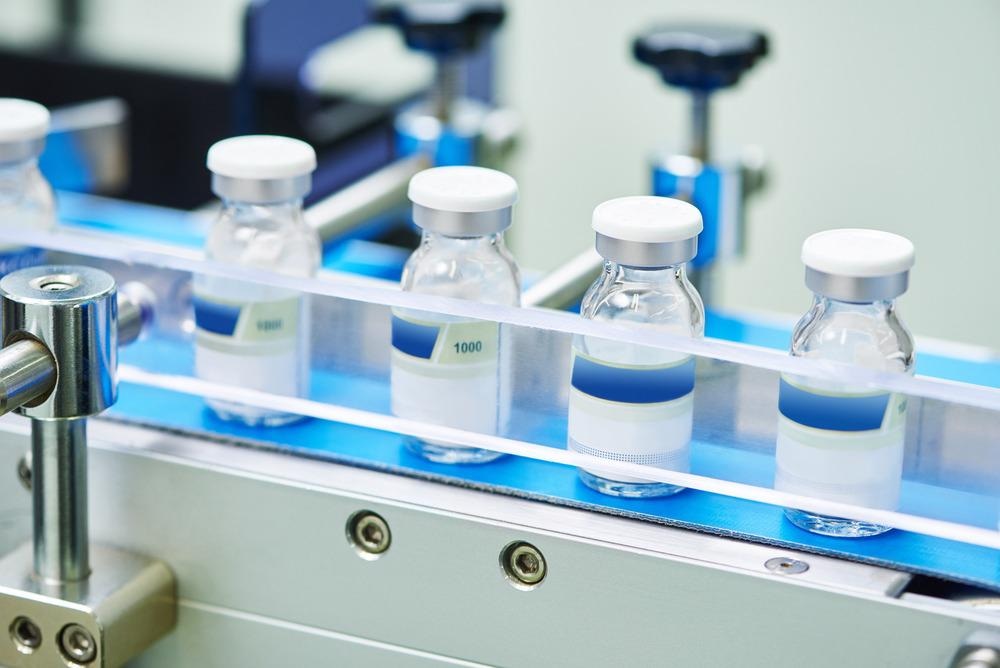
Image Credit: Dmitry Kalinovsky/Shutterstock.com
The design and development of appropriate packaging for pharmaceutical products are vital to ensure the safe transportation, storage, and administration of medicines, some of which could be life-saving. Pharmaceutical packaging is mainly constructed of plastic or glass. Glass is often preferable due to its properties that allow for easy sterilization and visibility of the product it contains. Here we discuss how glass is used in pharmaceutical packaging and what benefits its use brings.
Types of Glass Packaging for Pharmaceuticals
The pharmaceutical industry has used glass to produce safe and secure packaging for its vast array of products for many decades. This firm reliance on one material has been due to the various benefits it offers. Over the years, four main types of glass have been developed for use in pharmaceutical packaging.
Type 1: ultra-resistant borosilicate glass. This type of glass is chemically inert and highly resistant. Boron and aluminum-zinc molecules are used in borosilicate glass to replace the alkali’s and earth cations, resulting in a glass that is durable enough to contain strong acids and alkalis.
Type 2: surface treated soda-lime glass. This type of glass is even more chemically inert than borosilicate glass. Sulfur treatment is carried out on the soda-lime glass surface to prevent the weathering of the packaging it is used to create.
Type 3: regular soda-lime glass. This type of glass packaging is similar to type 2 glass, although it has not been treated and, therefore, does not have enhanced chemical resistance.
Type 4: general purpose soda-lime glass. Usually, this type of glass is only used to create packaging for products intended for oral or topical use.
It is common for glass to be colored to protect products from ultraviolet rays that can impact their function and efficacy. Amber and red are the most common colors used to block these harmful rays.
Advantages of Using Glass in Pharmaceutical Packaging
The use of glass in pharmaceutical packaging has many benefits. First, glass is incredibly resistant to temperature. This glass property is highly valuable to the pharmaceutical industry, whose products frequently need to be kept at certain temperatures to ensure that they are not damaged and their properties remain unchanged. Therefore, glass can be used to maintain the optimal temperature of the products it encases.
Glass is non-reactive to chemicals. It is a material that will not jeopardize the content’s purity, even when its outside surface becomes exposed to other products and chemicals.
Pharmaceutical products are composed of specific, calculated mixtures of molecules. Potential contamination of these products poses a significant risk to the people these medicines treat. Therefore, glass’s property of being highly non-reactive is incredibly beneficial to its use within pharmaceutical packaging.
Certain types of plastic, another commonly used material in pharmaceutical packaging, are reactive. This means that they cannot be used to package all kinds of pharmaceutical products as they can react with the products they are designed to package. Scientists investigate the chance of potential reactions before deciding on the most appropriate packaging option. As glass is non-reactive, it is often chosen as the safest option.
Another benefit of using glass in pharmaceutical packaging is that it does not leak like certain types of plastic (which can leak a chemical called Bisphenol A or BPA). It has been suggested that contamination of pharmaceutical products with BPA can negatively affect the brain and blood pressure. While clinical studies have yet to be conducted to confirm this link between BPA leakage and poor health outcomes, glass choice as a material for pharmaceutical packaging eliminates this risk.
Glass can also easily be sterilized and face high temperatures without denaturing, destroying bacteria and germs.
Finally, glass has several other properties that give it advantages as a pharmaceutical packaging material. For example, glass is not only tough and durable, but it can also be easily labeled and molded into bespoke shapes and sizes.
Future Directions for Pharmaceutical Packaging
Glass has many benefits as a pharmaceutical packaging material. While some experts foresee that the commonly used glass and elastomeric closure systems may eventually become outdated as scientists seek more effective barriers to protect life-saving therapies, glass will likely continue to be a key material in this sector.
The future of pharmaceutical packaging will see eco-friendly options being embraced, with recycled glass being a significant material. There is a current focus on developing strong, durable, safe, and sustainable pharmaceutical packaging. Bottles for tablets, syringes, and other pharmaceutical and medicinal products will likely continue to rely on glass for decades to come.
References and Further Reading
Singh, A., Sharma, P. and Malviya, R., 2011. Eco Friendly Pharmaceutical Packaging Material. World Applied Sciences Journal, 14(11), pp.1703-1716. https://citeseerx.ist.psu.edu/
Types of pharmaceutical packaging. Origin Ltd. Available at: https://www.originltd.com/useful-resources/product-information/types-of-pharmaceutical-packaging/
Vikas, P., 2014. Pharmaceutical packaging: Current trends and future. International Journal of Pharmacy and Pharmaceutical Sciences, 6(6), pp.480-485. https://www.researchgate.net/profile/Vikas_Pareek/publication/297091323_Pharmaceutical_packaging_Current_trends_and_future/links/59a696af4585156873cf9b3e/Pharmaceutical-packaging-Current-trends-and-future.pdf
Disclaimer: The views expressed here are those of the author expressed in their private capacity and do not necessarily represent the views of AZoM.com Limited T/A AZoNetwork the owner and operator of this website. This disclaimer forms part of the Terms and conditions of use of this website.